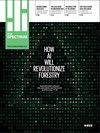第一代 Fitbit 的工程设计:健身追踪器的创造者拥有一个价值数十亿美元的创意--以及很多关于硬件的知识
IF 2.6
4区 工程技术
Q2 ENGINEERING, ELECTRICAL & ELECTRONIC
引用次数: 0
摘要
那是 2006 年 12 月。29 岁的企业家詹姆斯-帕克(James Park)刚刚购买了一套 Wii 游戏系统。其中包括售价 29 美元的手持控制器 Wii Nunchuk,它带有运动传感器,可以让游戏玩家通过移动身体进行互动--比如挥动棒球,或者与虚拟伙伴进行拳击。本文章由计算机程序翻译,如有差异,请以英文原文为准。
Engineering the First Fitbit: The Fitness Tracker's Creators Had a Billion-Dollar Idea—and a Lot to Learn About Hardware
It was December 2006. Twenty-nine-year-old entrepreneur James Park had just purchased a Wii game system. It included the Wii Nunchuk, a US $29 handheld controller with motion sensors that let game players interact by moving their bodies–swinging at a baseball, say, or boxing with a virtual partner.
求助全文
通过发布文献求助,成功后即可免费获取论文全文。
去求助
来源期刊

IEEE Spectrum
工程技术-工程:电子与电气
CiteScore
2.50
自引率
0.00%
发文量
254
审稿时长
4-8 weeks
期刊介绍:
IEEE Spectrum Magazine, the flagship publication of the IEEE, explores the development, applications and implications of new technologies. It anticipates trends in engineering, science, and technology, and provides a forum for understanding, discussion and leadership in these areas.
IEEE Spectrum is the world''s leading engineering and scientific magazine. Read by over 300,000 engineers worldwide, Spectrum provides international coverage of all technical issues and advances in computers, communications, and electronics. Written in clear, concise language for the non-specialist, Spectrum''s high editorial standards and worldwide resources ensure technical accuracy and state-of-the-art relevance.
 求助内容:
求助内容: 应助结果提醒方式:
应助结果提醒方式:


